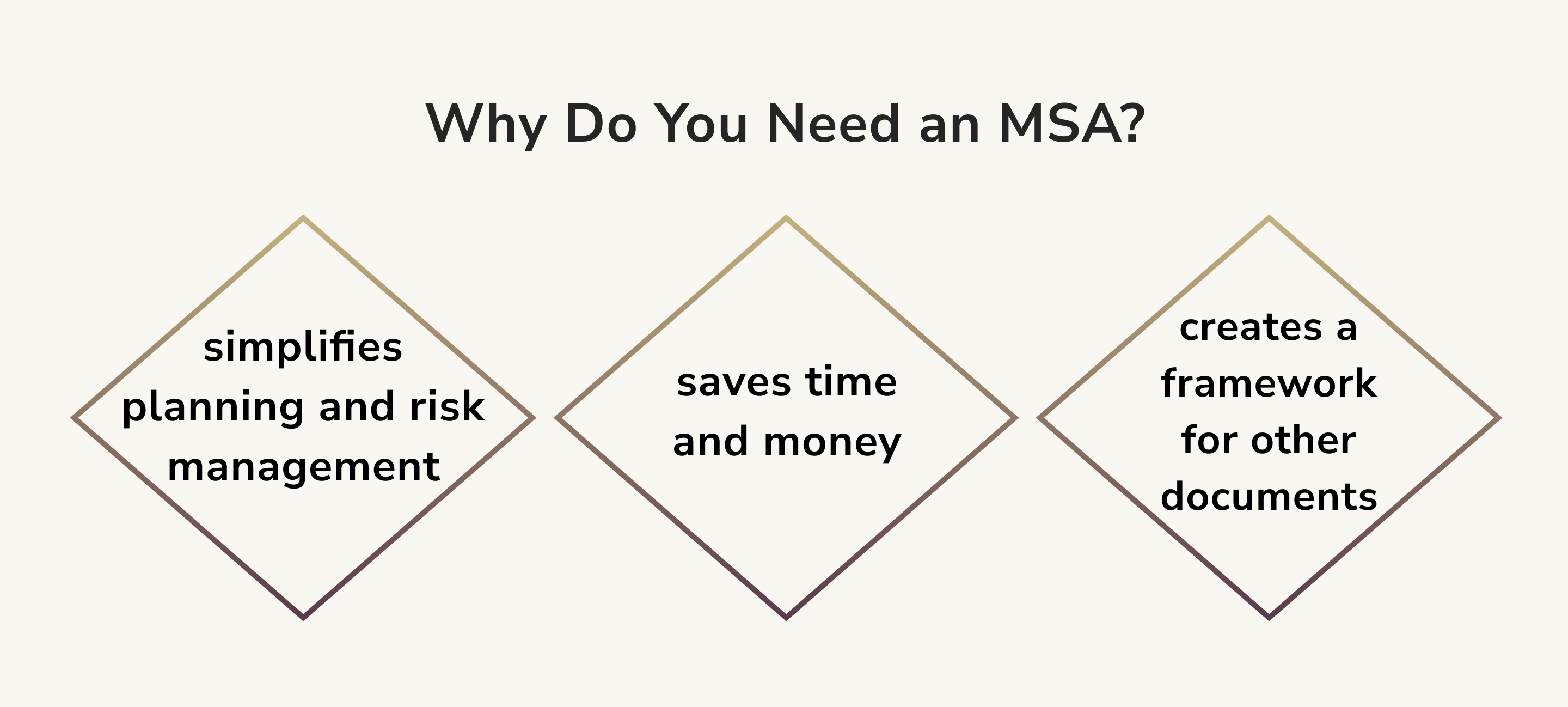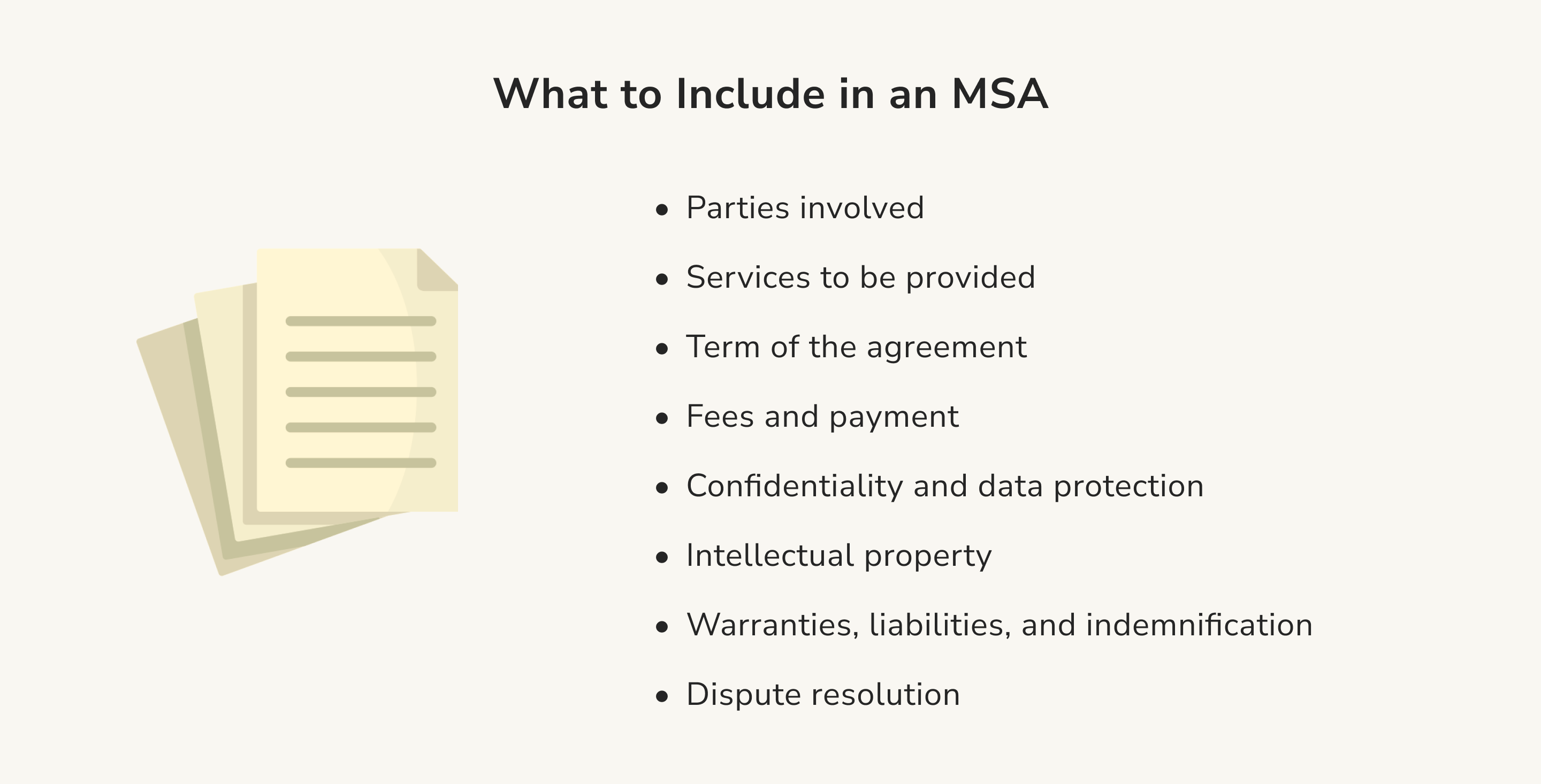Guide to Master Service Agreement in Outsourcing

If you scroll through our blog, you will find a whole series of articles on documents that are common to use in IT outsourcing. For instance, check our posts on the importance of technical documentation or how to create a perfect request for information.
Having well-thought-out and well-written documentation is exceptionally important in the case of IT outsourcing. It helps all sides of the agreement, including the customer, the services provider, and other possible vendors, to effectively protect their rights, secure themselves and make sure that the cooperation will be fruitful and successful.
In continuation of this series of articles, we present to you an article about another important type of document — the Master Service Agreement. So proceed to read this article to find out what this agreement is, why one would need it, and what are the essential parts of the Master Service Agreement.
What Is a Master Service Agreement (MSA)?
Let’s begin with the Master Service Agreement (MSA) definition. Generally speaking, the Master Service agreement is a contract between two or more parties that describes and defines all the conditions and terms of ongoing and future cooperation. Naturally, the MSA differs depending on the client, the industry, the number of parties involved, and the type of provided services. In this article, we will focus on the Master Service Agreement in IT outsourcing.
What Is the Meaning of an MSA?
Another important question to answer now before we get into details is what is the meaning of an MSA in business? Basically, one needs to sign Master Service Agreement for three reasons:
- MSA simplifies planning for the future and prepares all the parties involved for possible changes and risks. State of affairs changes, business landscape changes, and force majeure circumstances appear, but the existence of an MSA ensures that the cooperation between parties is flexible and has the ability to adjust to the situation and evolve;
- MSA saves time and money as it eliminates the need for repeated negotiations and defining the terms and conditions of cooperation each time there is a need for a specific contract;
- MSA also creates a framework for other documents (for example, Statement of Work) that would be drawn and signed in the course of the business relationship between the parties.

Who Drafts an MSA?
Usually, in the case of delivering software development services and IT outsourcing, the vendor prepares the draft of the agreement and presents it to the client. It is more convenient as the outsourcing vendor is most likely already have experience in preparing Master Service Agreements tailored specifically for software development\outsourcing. Also, they have a better understanding of the process and therefore can create a more detailed document. Then the client’s legal team can review it and make the necessary changes or adjustments. In this case, the MSA might be ready in a matter of days instead of days.
The client’s team can also take on this responsibility and prepare a Master Service Agreement draft themselves; however, in this case, the editing of the agreement may take more time. Especially if the client's team has never built an MSA for outsourcing before, and they will be writing a Master Service Agreement from scratch.
What Are the Benefits of a Master Service Agreement?
If you are still not convinced that an MSA is an essential document that would solve multiple potential problems (or even more — prevent them), we will give you a few more things to consider.
First of all, here is the list of events that might occur in the course of cooperation and influence it in one way or another:
- miscommunication;
- missed deadlines;
- failure to pay or unauthorized charges;
- injury or death of an employee;
- dissatisfying performance or service.
A proper Master Service Agreement delineates responsibilities in case of each of the aforementioned events. This eliminates the long and costly process of dispute resolution as all the course of action in every case is clear from what is written in the MSA contract.
We as well mentioned in the previous section that an MSA becomes a framework for the other types of agreements parties decide to sign in the process of their cooperation. Among the documents that are regulated by the Master Service Agreement are:
- Indemnification in the event of a third-party suit;
- Conditions of dispute resolution, alternative ways of dispute resolutions, and allocation of accompanying expenses;
- Royalties in case of new inventions;
- Release of the new information while maintaining NDAs;
- Work schedules depend on specific job conditions and others.
What to Include in an MSA
At this point, we can proceed to a detailed analysis of a typical MSA, considering what parts the Master Service Agreement consists of and how to correctly draw up this agreement.
Parties involved
First and foremost, the involved parties should be identified with detailed contact information and legal addresses added.
Any subsidiaries or affiliates that may be involved in the project should also be included here with their roles, rights, and responsibilities to avoid confusion.
Services to be provided
This section is usually called “Provision of Services” and follows the first general section. This might be the biggest and most important as it describes the specific services that will be provided by the vendor and outline any deliverables or milestones that must be met.
These usually include the following:
- overall objectives and goals for future projects;
- individual statement of work (SOW) with services provided;
- rules concerning SOW changes or order adjustments (such as fees, clauses, and processes);
- client’s expectations;
- progress reporting regulations;
- a brief guide to management and monitoring of performance;
- a clear work model account with working hours standards that take into account the vendor’s time zone
- rules and limitations regarding soliciting other contractors in the process of the development;
- Independence guarantees for all parties.
Term of the agreement
Usually, the MSA states the duration of the cooperation between the vendor and the client and is valid for the said duration. Additionally, it includes timeframes for the separate parts of the project and specific deadlines.
Provisions for premature termination of the agreement must be included in this section. An automated renewal procedure is also an option if both parties deem it necessary.
Fees and payment
This part of the agreement includes all the information concerning the fees, payment methods, and schedule. There are three payment methods in software development to choose from:
- Time and material: the client pays for the developer’s work per hour. It is the best option for projects that do not have identified scope yet so the team needs to remain flexible and ready for the possibility of changes.
- Fixed price: if, on the other hand, the project is well-planned, and has certain milestones and deadlines the fixed-priced model is the way to go. Usually, in this case, the project has a supposed delivery date, and the payment can be made after the project is completed and accepted by the client.
- Dedicated team model: in case of a complex project with a few separate teams involved, one should choose this payment model. The dedicated software development team gets monthly payments depending on the input that was made in the development of the project.
As soon as the most suitable payment method is chosen, one can proceed with writing a detailed description of payment terms. In addition, this section also includes acceptance criteria, the reasons for requesting the changes or adjustments in the project, or the rejection of the work results.
This section also lays out the necessary information about taxes, the consequences of late or missed payments, and unexpected expenses.

Confidentiality and data protection
This section includes provisions for the protection of confidential information and data. Details of which information is deemed confidential, who is allowed to have access to specific parts of the said information, what information is allowed to be opened to third parties, and what the repercussions of the confidentiality breach should be put in this part of the agreement.
Any relevant data protection laws and regulations that must be followed by both parties should be included here as well, especially if the parties reside in different countries and there might be ambiguity and differences in legislation.
You might as well check our article on the non-disclosure agreement, a document that is concluded solely for the purpose of data protection.
Intellectual property
The Master Service Agreement outlines the intellectual property rights of each party. It should be written out in detail which parts of the project’s deliverables (software, data, inventions, and/or technology) will be owned by the client, and which parts will remain in the ownership of the vendor.
If something needs to be copyrighted or patented, this information is also included in this section of the MSA.
Warranties, liabilities, and indemnification
The part of the agreement that concerns warranties and liabilities lists the person or people responsible for risk mitigation. It also includes limitations of liability in case of indirect or consequential damage that none of the parties is responsible for. However, one should list the exceptions as well if there is a decision to make some.
The indemnification section is necessary to record the outcomes in the case if either party fails to adhere to the MSA terms. If such failure results in monetary losses, data breach, reputational damages, or copyright infringement this section will explain how the responsible party in the event of any claims or legal action will compensate for the harm. Exclusions from indemnities are also listed here.
Dispute resolution
Here one should specify how disputes or disagreements between the parties will be resolved, such as through mediation or arbitration.
Conclusion
The importance and benefits of the conclusion of the Master Service Agreement between the client and the IT outsourcing vendor can’t be doubted. It significantly simplifies cooperation and allows the sides to successfully develop business relationships without worrying about small issues that might appear in the process.
Carefully reviewed and negotiated terms of the MSA ensure that this document meets the needs and expectations of both parties and works to the benefit of everyone involved. If you have any questions or are interested in finding a reliable and professional IT outsourcing team, please contact us — the Impressit team is always available and ready to help!

Roman Zomko
Other articles